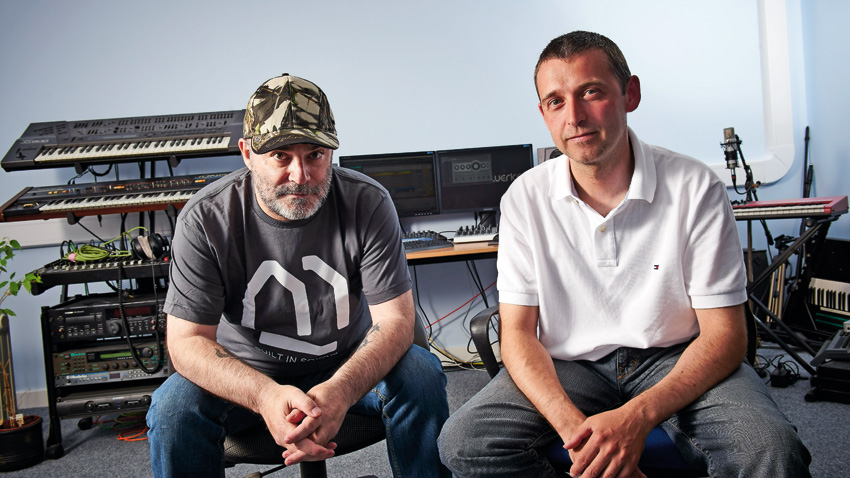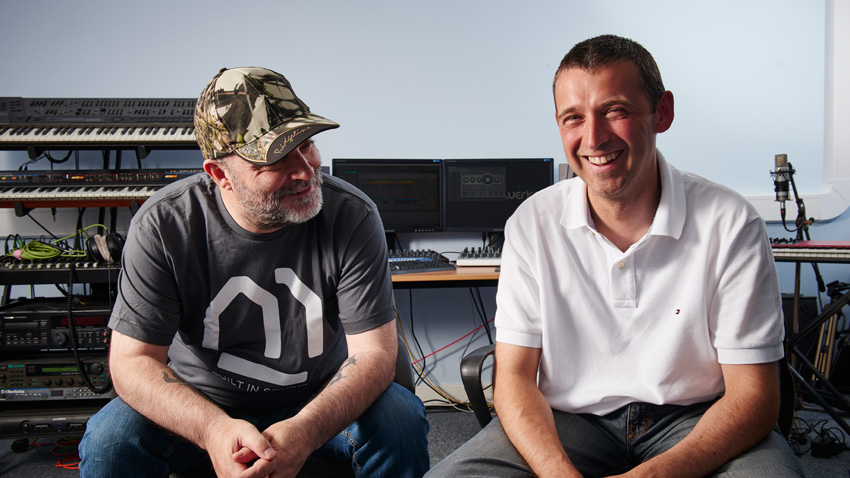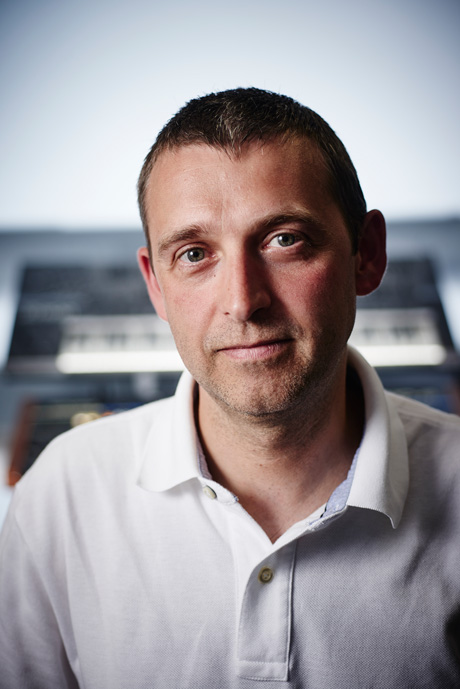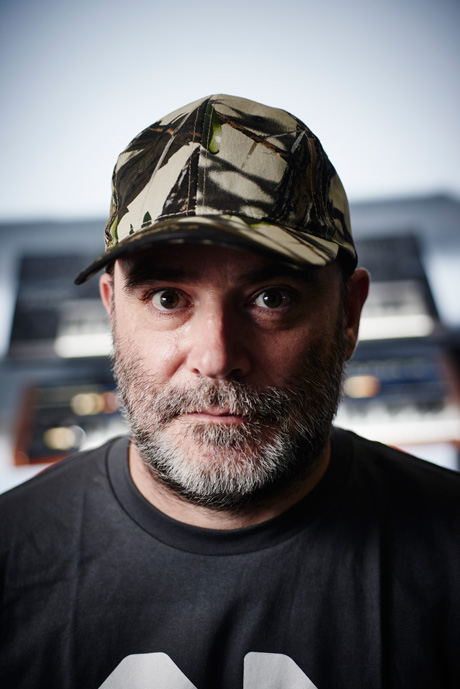The Black Dog on building their own MIDI controller and over two decades of making music
Martin and Richard Dust of techno pioneers The Black Dog discuss the manufacturing process behind their own MIDI controller, and the making of their latest album

What do you do when you've tried every DJ controller on the market but found that none of them really hits the sweet spot? You make your own, of course. That's exactly the journey that Richard and Martin Dust of techno stalwarts The Black Dog embarked on, using Kickstarter to fire up a project that required at least £27,000 to fund.
In the meantime, founding member Ken Downie motioned his brothers in arms to record a 12th studio album, Neither/Neither. The Black Dog have come a long way since their fruitful emergence from Warp's Artificial Intelligence series in the early 90s. The new album pays testament to the group's longevity, enshrining political doctrines through an amalgam of melodic ambient techno and dark, gripping beats.

What was the initial idea behind the Kickstarter campaign to design your own DJ controller, the CS X51?
Martin Dust: "I think it came about because we'd owned every single controller on the market and simply couldn't find anything that would do what we want it to do, so rather stupidly we thought we'd invent one. The Novation's got too many buttons, the M-Audio X-Session hasn't got enough sliders or knobs; we just couldn't find a happy medium. We only want to carry a 10kg bag, so we needed something that would fit in a bag as well."
How much money did you need to raise?
MD: "We needed to raise £27,000 for manufacturing, and got one or two thousand over the target. It's the first time we'd ever designed a PCB (Printed Circuit Board) and 20 years since I'd done any fabrication. I'm used to working with social media and talking to people, so that side was fairly easy, but the manufacturing side was a massive learning curve; like how big a gap you needed to leave so that the device would actually come out of a machine and you could fit a PCB… We'd ask people like Native Instruments, but nobody would tell us anything. For example, we were looking for a method where you insert a stud into aluminium - it's called blind studding - but nobody would tell us; so we'd spend a lot of time taking other people's machines apart to try and learn how we could build it ourselves. I think we were slightly crazy."
How was the money allocated in order to manufacture the device?
Want all the hottest music and gear news, reviews, deals, features and more, direct to your inbox? Sign up here.
MD: "We looked at doing a small run and had already built eight master PCBs and a controller board for the MIDI and the audio. Everything went into development, but I think we're still about two grand down because we decided to add a few more buttons. Of course, you've got to build a prototype, which is very expensive. It's really nerve-wracking when you're handing over a PCB join, because if anything's wrong with that you've got 500 that are all wrong."
As the creators, is the finished product exactly how you imagined it would be?
MD: "Yes, but there are so many versions on our studio floor. We built the first ones out of MDF. Doing controller design is pretty much like designing a poster - it looks really good on a computer but it's the actual physical testing of the knobs, buttons and sliders and their distance apart that matters. It's the field testers that made a difference. We got a friend that does laser cutting with plastic to do the front fascia for us, and I think we did at least 20 that looked fantastic, but they simply didn't work when we were trying
to play live."
Did you have any software design experience before coming into this world?
Richard Dust: "We've all done a bit of programming; Martin and I used to work for a games company. We did a short brief, got an expert in to art it and a programmer to create the application on the computer and configure the controller, then we got a second programmer in who did the firmware for all the MIDI controls. Again, it was quite a learning curve to keep up with what they were doing, because it became very technical. It's the same chip that's in the iPhone 4, so it's quite a powerful processor; far more powerful than we actually needed, but that gave us a lot of flexibility too."
Which gaming company was it that you both worked for?
MD: "Gremlin Interactive. The company started from a £1,000 government loan and went on to employ 375 people. We worked on everything from Spectrum games to all the other new Bus PCI platforms within that 10-15-year period. They were really good times. I was the creative director, so I worked on graphic design, packaging and game design. Rich worked on the music - spot effects and sound effects. The biggest games we worked on were the football games - Actua Soccer, Euro 96 - and Manic Miner. That had to be pixel-perfect [laughs]. It seems like a world ago now."
What makes you more proud - the fact that you created the product itself or that you managed to build a small manufacturing base in Sheffield?
MD: "For me, the most pleasing thing is that it worked straight out of the box and also looks really nice. We did a lot of prototypes that we thought would look nice, but when you went to visit the factory you knew immediately that it was wrong and you couldn't sell it."
RD: "The build quality of it, as well. It looks like a tank in comparison to all the plastic controllers around. That was one of the goals, to build something substantial that would stand up to all the beatings it would take on the road. We're really happy we achieved that; high-end controls and a good, solid, sturdy case. We kind of wanted to make it look like Apple had made it."
What else do you use in your DJ setup?
MD: "That's basically it. We used to take a lot of synths and machines out with us, but they weren't lasting long. The Virus would get full of sweat and make-up, and a lot of promoters didn't want to pay £250 to cart things around, so we've slimmed everything down to a MacBook Pro, the controller, a couple of Korg effects processors and a small mixer desk. If somebody exclusively wants a live set, we'll do our own stuff, but it's a party after all, so we've always got eight or nine different sets that we're working on. We always change them before we play, and go and watch what DJs are doing before; but at festivals some DJs are impossible to follow; they're playing hit after hit and finishing with a jungle track at 180bpm - it's fucking crazy."
Do you DJ as a trio?
MD: "Ken joins in occasionally, but he hates it, so we don't force him to do anything that he doesn't want to. We had a really bad experience at Bestival. We were playing the last tent open, but the previous night they'd had the volume that loud they'd kept people awake, so we went on to play and were told before we started playing, 'No kick drums'. The volume was so ridiculously low that everybody was coming to the front. Ken was saying, 'Turn the fucking music up' - I don't think it's an environment that he enjoys."
Do you have any further ideas for manufacturing gear?
MD: "Yeah, we've got a couple of ideas. One is for a bass synth, and we were talking to Chris Carter of Throbbing Gristle about updating the Gristler, which is a distortion unit. I don't know if you remember the old electronics magazines, where you could build your own fuzz box? That's where it came from; Chris used to put everything through it. We're still recovering from doing the X51, so we've put those ideas on ice because we want to go back to doing music."
"We'd owned every single controller and couldn't find anything that would do what we wanted, so we thought we'd invent one."
How did you and Richard get introduced to Ken?
MD: "We've known Ken since the start of Black Dog. Before the internet, we used to run a thing called Wildcat! BBS, which was like a version of the internet on your home computer. Black Dog used to have its own bulletin board system, so we used to talk to Ken on that and share ideas with him. Then, sometime around 2000, we started talking about doing music together and starting a record label."
The new album, Neither/Neither, has quite political undertones. What ideologies are you trying to get across in the music?
MD: "Because we live in Sheffield we've been on the wrong end of Tory governments for years. We've been looking at various propaganda processes, like Adam Curtis' work, Scientology, David Icke, terrorism, and the way that propaganda and the internet all interweaves - it's fucking crazy how stupid it is. You can't believe that once the processes are exposed it still continues.
"Neither/Neither came from the idea that there seems to be some kind of conspiracy to make us not understand what anything stands for any more, and if you don't know what people stand for then you've got to live with the voice against either way. I don't think we're about to turn into Billy Bragg and start giving lectures between each track, but we kind of hope people engage with it."
Would it be fair to say that there was a greater willingness to incorporate melody into the album?
RD: "I think there probably is more. Last year, we did a series of Sound of Sheffield singles, which were very much aimed at the clubs, so we had some ideas and projects sat on one side that we never developed. I think we all wanted to do something that was more musical, a bit slower and a bit more cerebral, not abiding by those clubs' rules.
"So, yeah, I think part of the album is the counterpoint to all those things - it was allowed to be more musical and much bigger. As soon as we add pads or lead lines, we get accused of making trance, so we know it's not trendy to have music in your music. We have a policy of 'make music and be damned'. The day we make a perfect album - and I think Ken would agree it's never happened - will probably be the day we pack it in."

Do you always work collectively in the studio?
MD: "No, I don't think there are any rules within Black Dog other than Rich doing the final mixdown, simply because he's got the best ears and he's the only one patient enough to spend any time sorting all the frequencies with our mastering guy, Simon Francis. We've got three machines in the studio with outboard kit on, we've all got Mac Pros, we've all got iPads, and they're all connected via Google Drive, so we just start throwing ideas up - we've never had a set process, really."
RD: "We're all sharing project files, samples, big ideas and part renders of tracks, and we send them backwards and forwards. After someone else has touched it, the next time you hear it, all your parts have been mangled and changed, and it can be a completely different track. It's a good way of getting plenty of new ideas in that you would never have thought of on your own. It's all available, it's all up for grabs and no one is really allowed to get precious over it, which does occasionally cause a few arguments and discussions, with one person saying, 'I really like that bit', and everyone else going, 'No, it's shit'."
Is nobody collating those ideas centrally to create a core structure for the music?
MD: "There's no structure to who does what. From discussions we start to come up with themes of what we want to write about. I guess when you've been friends for such a long time, you don't actually need to say that much."
RD: "When we start, we create simple banks of samples to try and get some very basic loops and tones going, just to try and set the tone and style that we want to start with. That usually gets completely thrown out the window by the end of the project, but because it's a start point, it helps us all to focus on a certain idea. We throw press cuttings into a folder, movies and YouTube links, so I guess we're creating an overall mood with everything that's available. It's not just Ableton project files we're throwing into the folders, but any kind of reference source we feel will be useful."
MD: "We're also on the top floor inside a factory on an industrial estate, which means we can play music as loud as we want at any time. We've got a large studio area and a performance area, which is where Ken projects movies onto a black wall, then we practise and practise, jamming things out using three laptops and controllers and recording all that in. It's just like old-style band jamming, trying to find that base of where it's going to go, and it's still great fun to do that."
Has compression become a bad habit?
MD: "Yeah, you can see it when we listen to promos. We drop them in Ableton and it's one big black block - and there's no need. I think it's a desperate attempt for more and more impact. It came from radio, where they wanted their track to be louder than the previous one, which made no fucking sense because they had compressors on, so it would all be coming out at the same volume anyway. It's a man's attitude really; we've worked with the same sound engineer and mastering guy for 15 years and don't even need to talk to him anymore; it just comes back right. I guess we've never been into loudness wars or trends, because it really dates things. It's like with modular synths now, you can tell that '90s techno is coming back simply because everybody's jumped on the bandwagon and got a little modular hooked up to their machine."

Some artists do seem to have a genuine affinity for modular. Is it something you've discarded because it's difficult to get precise results?
RD: "It can be difficult, yes. I think, for us, that kind of stuff is interesting but a massive distraction. You can spend hours tweaking and poking, but you're not actually producing what you're thinking of in your head. We're so used to using the kit we've got now that between the hardware and dropping it into the software, we've become quite proficient at producing the sound we want to produce."
MD: "I can understand why people buy them, because they look great and you can constantly update them. Artists and DJs have always had a problem with standing on stage and not looking as if they're doing anything, and a modular is a perfect example of being able to look really busy, but we've never fallen into that trap really. I'm afraid if you're looking at us three, you've got it wrong - you should be dancing."
Do you turn to software for mixing in the box?
RD: "The final mix is generally done in the box, but we still sometimes pass it back out to other units if we want a particular sound. If there's one thing we've really invested in, it's the older cranky kit that adds a dirty bit of hiss or noise here and there; that is quite pleasing in some cases. Like the old mixer we monitor through; it's about 20 years old and adds all sorts of weird hum to signals, which it's not supposed to, but it works for us."
MD: "It's a Studiomaster Diamond 16-2; I bought it for £150 from a second-hand shop. Everything on it's really noisy, but it has a really warm character so, as long as you're not touching anything while you're playing it, you're alright."
"I wouldn't mind the full Native Instruments studio box set that comes on a hard disk, but I'm banned from getting that, because if I did, nothing would actually get done."
You mentioned Ableton before. Is that your choice of DAW, and what plugins or soft synths do you use?
RD: "Ableton's become our software of choice, simply because we've all got it and can easily standardise the plugins. We use the Virus for bass and Nord Wave for pads, but no more than we use the Roland JD-800; and we still use Spectrasonics Atmosphere for underpinning pads, basic strings and tones. We use iZotope Ozone quite a bit for balancing, especially for controlling buss tracks and master tracks; and Native Instruments plugins as well, but again, we try not to overload Ableton with stuff because it becomes a distraction. Every time you add a new soft synth or plugin for an effect, you end up fiddling around for a day or two."
What about beats?
RD: "A lot of the percussion is all sample-based and entirely within the Drum Racks of Ableton. We chop and cut samples in, render out loops and re-crop and reprocess them, so we end up with samples that have been recycled multiple times. Creating drum racks is a fairly new process we've got into, because it speeds things up and we're able to write faster. The same Drum Rack source can be used several times, even though it ends up sounding very different in the final mix."
MD: "I think, like anyone that's owned a studio, we've all made that fatal mistake of buying eight pieces of kit in one go because you've got enough cash, installed it and spent a year doing nothing. So I don't think it's by choice, just the way things have naturally evolved. I wouldn't mind the full Native Instruments studio box set that comes on a hard disk, but I'm banned from getting that, because if I did, nothing would actually get done."
The Black Dog's latest, Neither/Neither, is out now via Dust Science. For news and DJ dates head to their website.


Future Music is the number one magazine for today's producers. Packed with technique and technology we'll help you make great new music. All-access artist interviews, in-depth gear reviews, essential production tutorials and much more. Every marvellous monthly edition features reliable reviews of the latest and greatest hardware and software technology and techniques, unparalleled advice, in-depth interviews, sensational free samples and so much more to improve the experience and outcome of your music-making.
